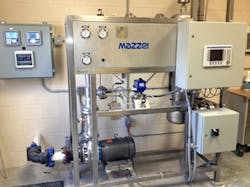Odor and color are problems for many rural water providers. High reliance on well water increases the chances of encountering sulfur, tannins and other contaminants, while small ratepayer bases make it difficult to afford expensive treatment systems. Like many rural water providers, the Four Way Special Utility District in Angelina County, Texas, was concerned about total trihalomethanes (TTHM), color and odor problems. The district operates a 900-gpm water well with a 750-gpm pump. Its well water was found to be tinted to 30 platinum-cobalt units and contained 0.4 mg/L hydrogen sulfide.
In Texas, tight regulations on trihalomethanes eliminated chlorination as an option for Four Way due to concerns about the production of TTHMs when using chlorine. Those regulations—in addition to ozone’s efficiency, effectiveness and the reduced need for storage and handling of chemicals—have led ozone to become a popular choice for rural water providers throughout Texas. However, Four Way was also concerned that a long hydraulic residence time and excess ozone in the contact tower could allow bromates to form.
The Solution
In 2013, Goodwin-Lasiter of Lufkin, Texas—with the help of Clark Water Treatment in Nacogdoches, Texas—determined that a precisely delivered dose of no more than 3.0 mg/L of ozone through a Mazzei 3090 GDT ozone transfer system would provide the performance needed to remove color and odor while minimizing the production of bromates and TTHMs.
The skid-mounted ozonation system includes a Venturi injector to dissolve ozone into a treatment water sidestream, a gas-liquid separator to remove and release undissolved ozone to a gas destruct system, and a pipeline flash reactor to inject the ozonated sidestream water into the main pipeline and ensure thorough mixing and mass transfer. A dissolved ozone sensor and PLC PID loop govern the process, ensuring efficacy, safety and efficiency.
Early ozone systems relied on bubble diffusers and positive pressure to mix ozone with water, a process with a mass transfer rate in the range of 10%. In contrast, sidestream systems using Venturi injectors enable mass transfer rates of 90% or more. Due to the unique geometry of these injectors, ozone is drawn in through a suction port when there is a pressure differential from the inlet to the outlet, utilizing the Venturi effect. The aerated sidestream is then mixed rapidly with the bulk water with minimal hydraulic residence time or contact time.
The use of computational fluid dynamics (CFD) by experienced engineers allows for the optimization of gas transfer and mixing by modeling the results of design decisions such as the placement of nozzles in the pipeline flash reactor or highlighting anomalies in flow that can affect the ozonation process. For retrofits, CFD modeling can help in foreseeing challenges that may arise while integrating skids with existing plumbing, and it can be used to provide carefully engineered solutions. In new installations, using CFD modeling in close communication with design engineers can help optimize performance, add flexibility to the design process and aid in reducing energy costs.
The Results
With Four Way’s ozone generator producing 730 g of ozone per hour, the district’s system achieves its performance objectives with a rate of just 2.8 mg/L of ozone. In fact, added pathogen control from ozonation has allowed Four Way to reduce its dosage of chlorine for disinfection, and the district has even decommissioned the energy-intensive air stripping process it formerly used for volatile organic compound removal.
Jim Lauria is vice president, sales and marketing, for Mazzei Injector Co. Lauria can be reached at 661.363.6500 or [email protected].



